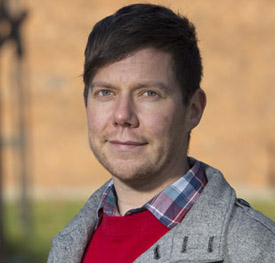Class coincides with outreach to transgender students

In Aren Aizura’s class “Introduction to Transgender Studies" – the first class of its kind at Rutgers – students analyze footage of Christine Jorgensen upon her return to the United States after a sex change operation in Denmark.
With her throaty voice and resemblance to Joan Crawford, Jorgensen fascinated the world as one of the first men to undergo gender reassignment surgery in 1952. (“Ex-GI turned Blonde Beauty’’ blared one headline.)
The Rutgers class explores the history and politics of what it means to be transgender, including the criteria physicians once used to determine whether someone would be a good candidate for surgery.
“Thirty or 40 years ago, if you were male to female and attracted to women, they [surgeons} just wouldn’t do it,’’ says Aizura, a postdoctoral associate in the Department of Gender and Women’s Studies in the School of Arts and Sciences.
Many assume that transgender means “switching’’ from one gender to another and crossing a clear-cut boundary. But it doesn’t, says Aizura, who is transgender himself.
Jorgensen worked hard to learn so-called feminine mannerisms during the process of changing gender, Aizura told the class. It was Jorgensen’s goal to pass as female.
But toward the end of the 20th century, sexuality and gender became more fluid concepts than they were in Jorgensen’s day. A new identity emerged in which transgender people began to identify as the opposite gender without modifying their bodies or cross-dressing.
“Today people can have a complicated understanding of gender that can change throughout their lifetimes,’’ Aizura says. “It’s not necessarily a process that’s finished, that means you come out the other end looking like a ‘normal’ man or woman.
Aizura’s class is one of a smattering of transgender studies courses in the nation and coincides with Rutgers outreach efforts to transgender students. When Jenny Kurtz, director of Rutgers’ Center for Social Justice Education and LGBT Communities, came to Rutgers four years ago, there was one self-identified transgender student on campus. Now there are at least 35, she says.
“When you have programs and resources, people are more likely to come out and say, ‘hey, I’m not the only member of this community,’’’Kurtz says.
Kurtz's office is in the process of surveying transgender students about their concerns and reviewing existing policies at Rutgers to see what could be improved. More gender neutral bathrooms are high on the list, as is a more well-defined policy on transgender athletes (for instance, whether transgender students can compete on male or female teams despite their biological gender).
From November 12 -16, the center is holding TransWeek, five days of programming and events exploring transgender issues.
In Aizura’s class, most students don’t appear to be transgender, but it isn’t always easy to tell and he doesn’t expect anyone to declare themselves.
“One thing I do is ask people what kind of pronouns they would prefer,’’ says Aizura. “It breaks down people’s assumptions that the gender they see someone as is the gender that identifies them."
For Long Pham, who is majoring in women’s, gender and sexualities studies, the class has deepened his belief that gender is a “label’’ which can constrict self-expression and identity.
“I don’t believe in labels,’’ he says. “There is..a massive potentiality in non-labeling. I don’t need to refer to myself as x, y or z.’’
Elaf Saeed, a sophomore major in biology, who is Muslim, enrolled in the class after taking an honors seminar called “Introduction to 20th Century Sex Change.”
“I thought it was interesting and wanted to learn more,’’ says Saeed. “A lot of people think I’m completely intolerant of sexual variation but I’m not. I think this is a new culture arising, and why not learn about it?’’